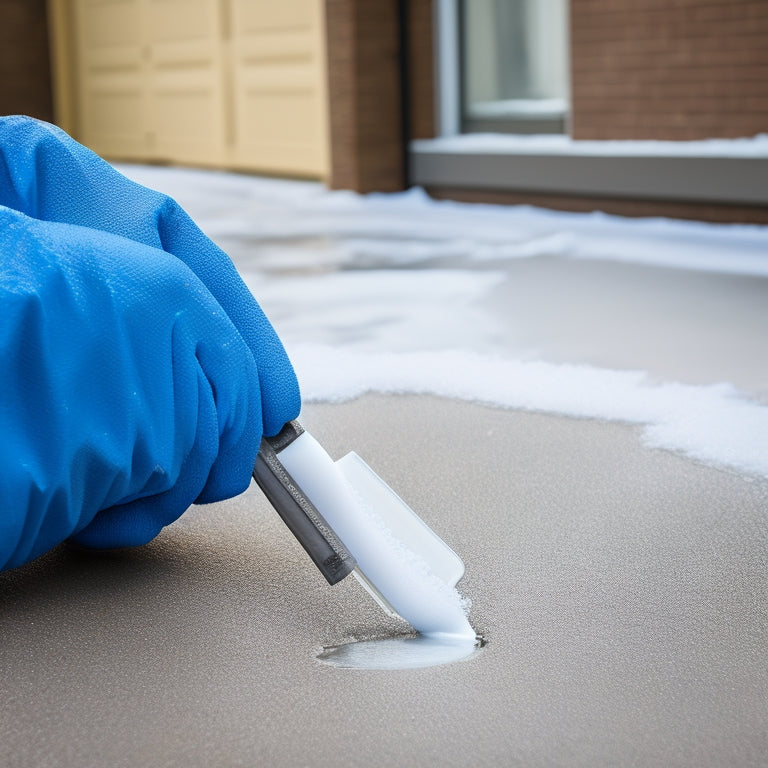
Cold Weather Crack Filling Tools for Home Renovation
Share
When filling cracks in your home's concrete surfaces during cold weather, you'll need the right tools to guarantee a strong, long-lasting bond between the sealant and the concrete. Invest in high-quality tools like epoxy injection guns, polyurethane foam kits, and specialized chisels designed for cold weather use. These tools will help you prepare the surface, remove debris, and fill cracks efficiently. Advanced adhesives and low-temperature sealant application guns will also help you achieve professional results. By choosing the right tools for the job, you'll be well on your way to successfully renovating your home's concrete surfaces, and there's more to explore in this process.
Key Takeaways
• For cold weather crack filling, use specialized tools like epoxy injection guns and low-temperature sealant application guns for reliable performance.
• High-flow polyurethane foam kits are ideal for filling large cracks or voids quickly in cold weather, providing exceptional insulation properties.
• Adjustable pressure control and interchangeable nozzles and tips in crack filling tools allow for customization to crack size and type.
• Cold weather-specific crack filling tools, such as chisels and wedges, are designed for effective removal of dirt and debris from concrete surfaces.
• Advanced concrete repair adhesives provide superior bonding strength and durability, resisting environmental stressors and extreme temperatures in cold weather.
Best Concrete Crack Filling Tools
What makes a concrete crack filling tool stand out from the rest, and which ones do you need in your arsenal to tackle the toughest cracks?
When it comes to mastering crack sealing techniques, having the right tools is essential. A high-quality crack filling tool should be able to effectively prepare the concrete surface for sealing, ensuring a strong bond between the sealant and the concrete. You'll need a tool that can efficiently remove dirt, debris, and old sealant from the crack, leaving a clean surface for the new sealant.
Look for a tool with adjustable pressure control, allowing you to tailor the pressure to the specific crack size and type. Additionally, a tool with interchangeable nozzles and tips will give you the versatility to tackle cracks of varying widths and depths.
Cold Weather Epoxy Injection Guns
You'll need a cold weather epoxy injection gun that can withstand freezing temperatures and maintain a consistent flow of epoxy, guaranteeing a successful injection process even in the most challenging winter conditions.
When selecting a gun, consider the type of epoxy you'll be working with, as different guns are designed for specific epoxy types. For example, a gun designed for low-viscosity epoxies may not perform well with high-viscosity epoxies.
Look for guns with features such as heated hoses, insulated barrels, and cold-weather-resistant seals to guarantee reliable performance in cold temperatures. Additionally, consider the gun's flow rate, as a higher flow rate can help to fill cracks more efficiently.
Some cold weather epoxy injection guns also come with adjustable flow rates, allowing you to tailor the flow to the specific needs of your project.
High-Flow Polyurethane Foam Kits
When tackling large cracks or voids in cold weather, turning to high-flow polyurethane foam kits can provide the necessary speed and volume to guarantee a successful fill. These kits are specifically designed to dispense high-density foam at an accelerated rate, making sure that you can fill even the largest voids quickly and efficiently. The high-flow design also allows for better penetration into tight spaces, making it ideal for cold weather applications where time is of the essence.
As you work with high-flow polyurethane foam kits, you'll notice that the resulting foam has exceptional insulation properties. This is due to the high-density composition, which provides superior thermal resistance and minimizes heat transfer. This makes it an excellent choice for filling gaps and cracks in walls, floors, and ceilings, where energy efficiency is vital.
When using high-flow polyurethane foam kits, it's important to follow the manufacturer's instructions and take necessary safety precautions. Make sure you're wearing protective gear, including gloves and safety glasses, and work in a well-ventilated area to avoid inhaling foam fumes. With the right techniques and precautions, you'll be able to achieve professional-grade results and guarantee a successful cold weather crack fill.
Crack Filling Chisels and Wedges
As you prepare to fill cracks in cold weather, you'll need to select the right chisel type for the job, considering factors like crack width and material.
You'll also need to master wedge setting techniques to guarantee a secure and efficient fill.
Chisel Types and Uses
Several types of chisels and wedges are designed specifically for crack filling, each serving a unique purpose in the process. As you select the right tools for your project, consider the chisel materials and their impact on performance. For instance, carbide-tipped chisels are ideal for concrete and asphalt, while steel chisels are better suited for brick and stone.
| Chisel Type | Material | Best Use |
|---|---|---|
| Carbide-tipped | Concrete, Asphalt | Heavy-duty crack filling |
| Steel | Brick, Stone | Delicate crack filling |
| Diamond-coated | Hard surfaces | High-precision crack filling |
| Hand chisel | Versatile | General-purpose crack filling |
Proper chisel maintenance is also essential to extend the tool's lifespan and guarantee peak performance. Regularly clean and inspect your chisels for signs of wear, and store them in a dry place to prevent rust. By choosing the right chisel type and following proper maintenance procedures, you'll be able to tackle even the most challenging crack filling tasks with confidence. Remember, the right tools and techniques can make all the difference in achieving a successful and long-lasting repair.
Wedge Setting Techniques
You'll need to set your chisels and wedges correctly to guarantee a secure and even filling of the crack, which is where wedge setting techniques come into play.
To achieve ideal results, you must make certain of proper wedge alignment, which means positioning the wedge at a 90-degree angle to the crack. This allows for even pressure distribution and prevents the wedge from slipping out during the filling process.
Next, you'll need to assess the wedge durability, as a durable wedge can withstand the pressure and temperature fluctuations that come with cold weather crack filling.
When setting the wedge, start by gently tapping it into place with a hammer, then gradually increase the force as needed. It's crucial to monitor the wedge's alignment and adjust it as necessary to maintain even pressure.
Remember to keep the wedge clean and free of debris to guarantee a strong bond between the wedge and the surrounding material.
Advanced Concrete Repair Adhesives
Your crack-filling arsenal isn't complete without advanced concrete repair adhesives, which outperform traditional materials in bonding strength, durability, and resistance to environmental stressors.
These high-performance adhesives are specifically designed to overcome the challenges of cold weather crack filling, ensuring a strong and lasting bond between the adhesive and the concrete.
When it comes to adhesive performance, temperature effects play a critical role. Advanced concrete repair adhesives are formulated to maintain their bonding strength even in extreme cold temperatures, ensuring that your repairs remain effective throughout the winter months.
Additionally, these adhesives are resistant to freeze-thaw cycles, which can cause traditional materials to degrade over time.
Some key benefits of advanced concrete repair adhesives include:
-
Improved bonding strength and durability
-
Enhanced resistance to environmental stressors, such as temperature fluctuations and moisture
-
Faster set times and improved workability, even in cold temperatures
Low-Temperature Sealant Application Guns
By the time you're ready to apply sealant to the crack, the right tool can make all the difference, which is where low-temperature sealant application guns come into play. These specialized guns are designed to handle the challenges of cold weather crack filling, ensuring a smooth and consistent application of sealant even in freezing temperatures.
When working with low-temperature sealants, it's essential to understand the temperature impact on the sealant's viscosity and flow rate. Low-temperature sealant application guns are engineered to maintain the ideal pressure and flow rate, ensuring a professional-grade finish. Additionally, these guns often feature insulated handles and ergonomic design, reducing fatigue and improving control.
To get the most out of your low-temperature sealant application gun, follow these sealant maintenance tips:
-
Regularly clean the gun's nozzle and barrel to prevent clogging.
-
Store the gun in a warm dry place.
-
Always refer to the manufacturer's instructions for specific usage guidelines.
Frequently Asked Questions
Can I Use Cold Weather Crack Filling Tools on Freshly Poured Concrete?
When you're working with freshly poured concrete, you'll want to exercise caution before using cold weather crack filling tools.
Remember that concrete curing is a delicate process, and introducing filling tools too soon can compromise the integrity of the concrete.
Wait until the concrete has fully cured, as specified by the manufacturer's instructions, before applying cold weather crack filling tools to guarantee a strong and durable finish.
How Do I Ensure a Strong Bond Between Old and New Concrete?
To guarantee a strong bond between old and new concrete, you'll need to focus on surface preparation and bonding techniques.
Start by cleaning the old concrete surface to remove dirt, oil, and other contaminants.
Then, apply a bonding agent to the prepared surface, following the manufacturer's instructions.
Next, roughen the surface using a wire brush or acid etching to create a mechanical bond.
What Safety Precautions Should I Take When Using Epoxy Injection Guns?
As you commence on the epoxy injection process, remember that safety should be your top priority, not an afterthought.
When using epoxy injection guns, you'll want to don protective gear, including gloves, goggles, and a mask, to shield yourself from the sticky, potentially hazardous resin.
Perfect your injection technique to avoid messy spills, and always follow the manufacturer's guidelines for epoxy safety.
Can I Apply Sealants in Temperatures Below Freezing?
When applying sealants in freezing temperatures, you'll need to take into account the sealant's effectiveness and temperature considerations.
Most sealants are formulated to work best between 40°F and 90°F (4°C and 32°C). Applying below freezing can impede curing, reducing bond strength and overall performance.
Check the manufacturer's recommendations, and if necessary, use specialized sealants designed for cold-weather applications.
Always follow the instructions and take necessary precautions to guarantee a successful seal.
How Do I Remove Excess Polyurethane Foam After Application?
When it's time to remove excess polyurethane foam after application, you'll need to employ effective foam removal techniques.
First, let the foam cure completely, then use a utility knife or putty knife to scrape off as much excess as possible.
Next, apply a polyurethane cleanup method like mineral spirits or acetone to dissolve the remaining foam.
Be cautious, as these solvents can damage surrounding surfaces.
Wear protective gear and work in a well-ventilated area to guarantee a safe and successful cleanup.
Conclusion
As you wrap up your winter renovation, remember that cold weather crack filling requires the right arsenal.
With the best concrete crack filling tools in your corner, you'll be the master of your frozen domain, taming even the most stubborn cracks.
Don't let the chill of winter freeze your progress - release your inner repair warrior and conquer the cold with confidence!
Related Posts
-

7 Patio Safety Tips for DIY Renovation Projects
As you begin your DIY patio renovation project, prioritize safety by evaluating the worksite for tripping hazards and...
-

Renovation Tool Checklist for Smooth Finishes
When tackling a renovation project that requires a smooth finish, you'll need a thorough tool checklist to guarantee ...
-

3 Best DIY Home Renovation Timelines for Success
As you tackle your DIY home renovation project, create a solid timeline by breaking it down into three phases. First,...


